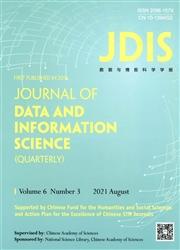医院的研究不端行为正在蔓延:对中国大学附属医院撤回论文的文献计量分析
IF 1.5
3区 管理学
Q2 INFORMATION SCIENCE & LIBRARY SCIENCE
引用次数: 0
摘要
摘要目的我国大学附属医院论文撤稿数量不断增加,引起了广泛关注。本研究的目的是分析2000年至2021年中国大陆大学附属医院的撤稿论文。设计/方法/方法1031篇撤稿论文的数据来自Web of Science Core collection数据库。有关医院的信息是从其官方网站上获得的。我们分析了撤稿论文的时间变化、期刊分布、学科分布和撤稿原因。并对所涉医院的等级和地理位置进行了探讨。我们发现论文被撤稿的数量在快速增加,而撤稿时间间隔在缩短。撤稿原因主要有抄袭/自我抄袭(n=255)、无效数据/图片/结论(n=212)、虚假同行评议(n=175)和诚信错误(n=163)。学科主要分布在肿瘤学(n=320)、药理学(n=320);药学(n=198)和研究&实验医学(n=166)。约43.8%的撤稿论文来自名牌大学附属医院。本研究未能区分因诚实错误而撤稿和因研究不当而撤稿。我们认为,诚实的错误撤稿和不当撤稿是有本质区别的。另一个限制是,撤回论文的作者没有在本研究中进行分析。本研究为我国大学附属医院的科研不端行为治理提供参考。我们建议,高校和医院应该对所有员工进行研究诚信基本规范的教育,对科学不端论文的作者进行处罚,改革不合理的评价制度。本研究在对撤稿论文进行分析的基础上,进一步分析撤稿论文的机构特征,可以深化对撤稿论文的研究,为理解撤稿现象提供一个新的视角。本文章由计算机程序翻译,如有差异,请以英文原文为准。
Research misconduct in hospitals is spreading: A bibliometric analysis of retracted papers from Chinese university-affiliated hospitals
Abstract Purpose The number of retracted papers from Chinese university-affiliated hospitals is increasing, which has raised much concern. The aim of this study is to analyze the retracted papers from university-affiliated hospitals in mainland China from 2000 to 2021. Design/methodology/approach Data for 1,031 retracted papers were identified from the Web of Science Core collection database. The information of the hospitals involved was obtained from their official websites. We analyzed the chronological changes, journal distribution, discipline distribution and retraction reasons for the retracted papers. The grade and geographic locations of the hospitals involved were explored as well. Findings We found a rapid increase in the number of retracted papers, while the retraction time interval is decreasing. The main reasons for retraction are plagiarism/self-plagiarism (n=255), invalid data/images/conclusions (n=212), fake peer review (n=175) and honesty error(n=163). The disciplines are mainly distributed in oncology (n=320), pharmacology & pharmacy (n=198) and research & experimental medicine (n=166). About 43.8% of the retracted papers were from hospitals affiliated with prestigious universities. Research limitations This study fails to differentiate between retractions due to honest error and retractions due to research misconduct. We believe that there is a fundamental difference between honest error retractions and misconduct retractions. Another limitation is that authors of the retracted papers have not been analyzed in this study. Practical implications This study provides a reference for addressing research misconduct in Chinese university-affiliated hospitals. It is our recommendation that universities and hospitals should educate all their staff about the basic norms of research integrity, punish authors of scientific misconduct retracted papers, and reform the unreasonable evaluation system. Originality/value Based on the analysis of retracted papers, this study further analyzes the characteristics of institutions of retracted papers, which may deepen the research on retracted papers and provide a new perspective to understand the retraction phenomenon.
求助全文
通过发布文献求助,成功后即可免费获取论文全文。
去求助
来源期刊

Journal of Data and Information Science
INFORMATION SCIENCE & LIBRARY SCIENCE-
CiteScore
3.50
自引率
6.70%
发文量
495
期刊介绍:
JDIS devotes itself to the study and application of the theories, methods, techniques, services, infrastructural facilities using big data to support knowledge discovery for decision & policy making. The basic emphasis is big data-based, analytics centered, knowledge discovery driven, and decision making supporting. The special effort is on the knowledge discovery to detect and predict structures, trends, behaviors, relations, evolutions and disruptions in research, innovation, business, politics, security, media and communications, and social development, where the big data may include metadata or full content data, text or non-textural data, structured or non-structural data, domain specific or cross-domain data, and dynamic or interactive data.
The main areas of interest are:
(1) New theories, methods, and techniques of big data based data mining, knowledge discovery, and informatics, including but not limited to scientometrics, communication analysis, social network analysis, tech & industry analysis, competitive intelligence, knowledge mapping, evidence based policy analysis, and predictive analysis.
(2) New methods, architectures, and facilities to develop or improve knowledge infrastructure capable to support knowledge organization and sophisticated analytics, including but not limited to ontology construction, knowledge organization, semantic linked data, knowledge integration and fusion, semantic retrieval, domain specific knowledge infrastructure, and semantic sciences.
(3) New mechanisms, methods, and tools to embed knowledge analytics and knowledge discovery into actual operation, service, or managerial processes, including but not limited to knowledge assisted scientific discovery, data mining driven intelligent workflows in learning, communications, and management.
Specific topic areas may include:
Knowledge organization
Knowledge discovery and data mining
Knowledge integration and fusion
Semantic Web metrics
Scientometrics
Analytic and diagnostic informetrics
Competitive intelligence
Predictive analysis
Social network analysis and metrics
Semantic and interactively analytic retrieval
Evidence-based policy analysis
Intelligent knowledge production
Knowledge-driven workflow management and decision-making
Knowledge-driven collaboration and its management
Domain knowledge infrastructure with knowledge fusion and analytics
Development of data and information services
 求助内容:
求助内容: 应助结果提醒方式:
应助结果提醒方式:


